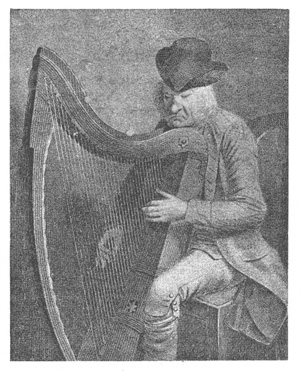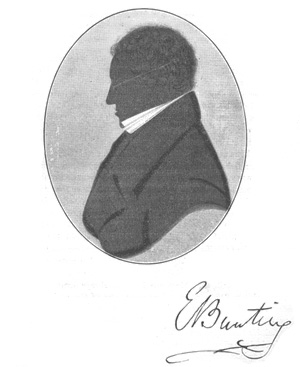Denis Hemsey or Hempson, Irish Harper
“The Irish Harpers in Belfast in 1792” … continued
BY ROBERT YOUNG, J.P., C.E.
From The Ulster Journal of Archaeology, Second Series, Volume 1, Number 2, 1895
« previous page | start of essay | next page »
Of the ten performers at this Belfast meeting very little is known except about the first two, who were in many respects quite remarkable, both as men and as harpers. Hempson may be considered the last of the genuine old Irish school, and O’Neill as a worthy representative of the more modern style of playing, as carried to perfection by Carolan.

Hempson, the Blind Harper of Magilligan, County Derry
Denis Hempsey was born in 1695 (twenty-five years after Carolan), at Craigmore, Co. Derry. His father was the owner of the townland of Tyrcrevan. He lost his eyesight by smallpox when three years of age.
His first teacher on the harp was Bridget O’Cahan; afterwards he had lessons from others, but specially from Pat Connor from Connacht, at that time celebrated for its harpers and music. He travelled for ten years through Ireland and Scotland. In 1745 he went the second time to Scotland, and, happening to be in Edinburgh at the time Prince Charlie was there, was brought before him, and played the popular air, “The king shall enjoy his own again.” When he attended the Belfast meeting he was in his ninety-seventh year.
Edward Bunting saw him at Magilligan the next year, and noted down several of his tunes and studied his special style of playing. In conversation with him about the other Harpers he did not conceal his opinion of his own superiority: “When I played the old tunes, not another of the Harpers would play after me.”

Silhouette of Edward Bunting
Shortly before his death, the Rev. Sir H. H. Bruce of Downhill paid him, a friendly visit, and when he found who his visitor was, he got himself raised up in bed and called for his harp. He made an attempt at the first notes of one of his favourite melodies, but, overcome by weakness, the harp slipped from his hands and he sank back, and so parted for ever from what had been his life-long companion. He died in 1807, at the great age of 112 years. “The last of our bards now sleeps cold in the grave,” was truly said when the news of his death was announced.
Hempson’s harp is said to be preserved at Downhill. The sides and front are of white sallow, the back of bog fir patched with copper and iron plates. The following lines are engraved on it:—
“In the days of Noah I was grown,
After his flood I’ve not been seen,
Until seventeen hundred and two. I was found
By Cormac Kelly under ground;
He raised me to that degree—
Queen of music they call me.”
